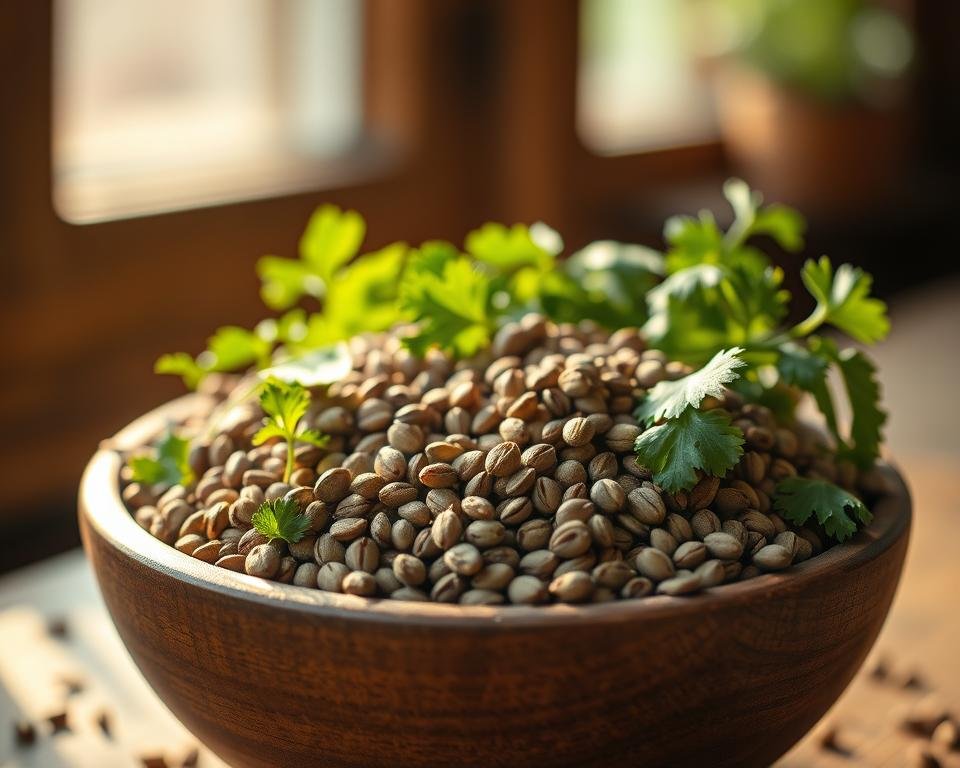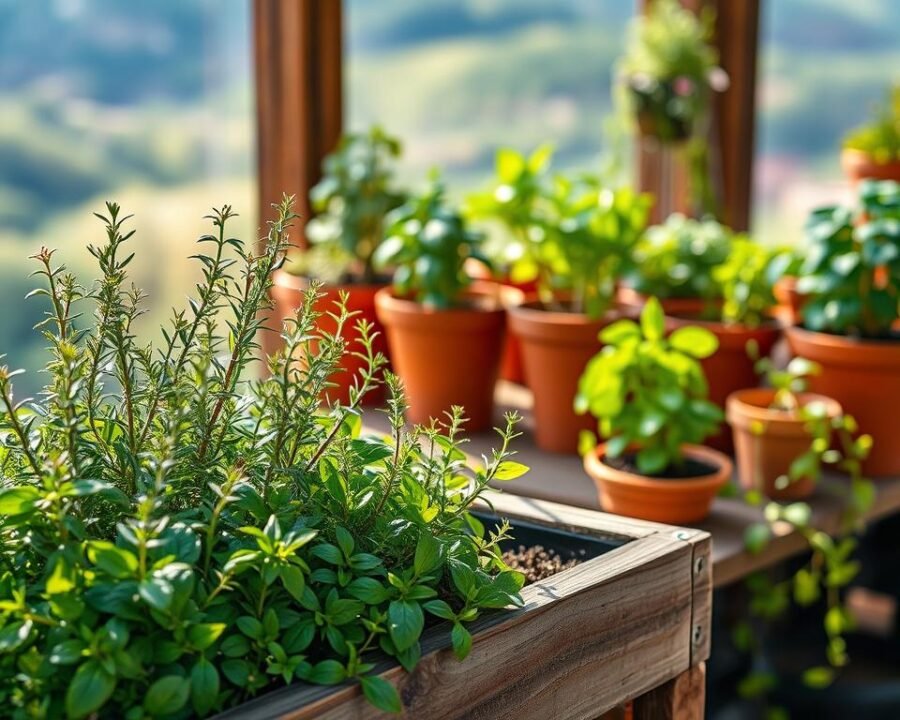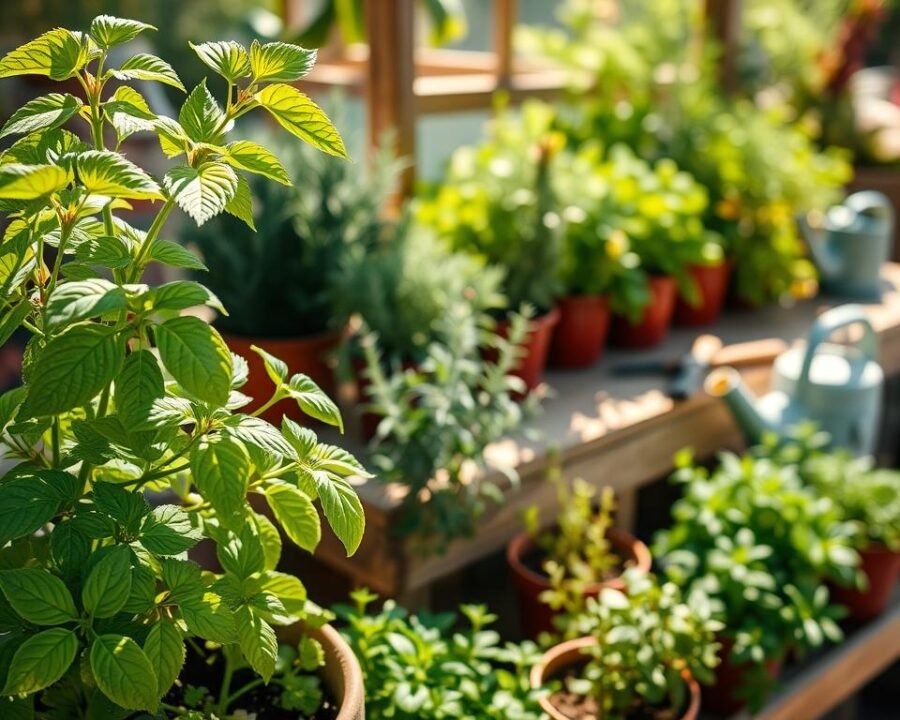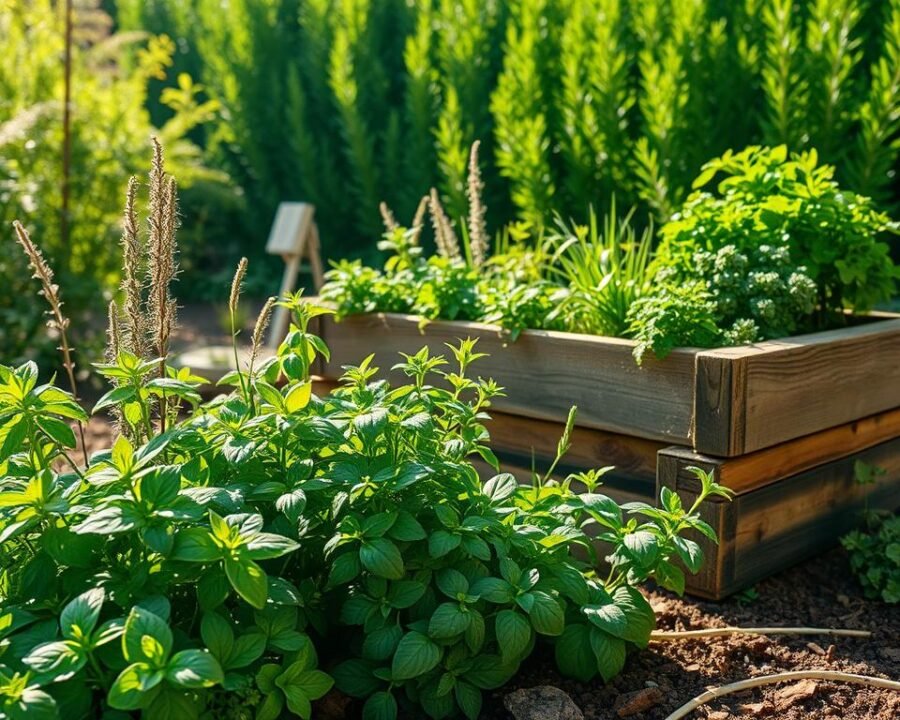There’s something magical about stepping into a garden filled with fragrant herbs. The scent of basil, the crispness of mint, and the earthy aroma of rosemary awaken the senses. More than just flavor enhancers, these plants bring life to kitchens and marketplaces alike.
Demand for homegrown herbs continues to rise, whether for personal use or local sales. With the right approach, even beginners can nurture thriving greenery. From supermarket cuttings to flourishing three-foot basil, success stories inspire new growers daily.
We’ll guide you through selecting high-yield varieties, smart sourcing, and maximizing harvests. Whether you dream of a backyard oasis or a small business, fresh herbs offer endless possibilities.
Key Takeaways
- Fresh culinary herbs are in high demand locally and online
- Basil, mint, and rosemary are profitable and easy to maintain
- Perennial herbs provide recurring harvests with minimal effort
- Small starts can grow into impressive, market-ready plants
- Proper selection and care boost both quality and sales potential
Why Growing Herb Plants for Sale Is a Profitable Venture
Local markets crave the crisp flavors of freshly harvested greens. Unlike mass-produced options, homegrown varieties offer unmatched taste and quality. Over 90% of kitchen favorites come from the Lamiaceae family, including *mint*, basil, and rosemary.
Perennial herbs like sage and thyme thrive for years. They survive frost and bounce back after cutting. This means continuous harvests with minimal replanting costs.
Consumers increasingly prefer organic, locally-sourced options. Supermarket bunches often lack flavor and freshness. A $5 basil start can yield $50 worth of leaves when nurtured properly.
- Low startup costs: Container gardening requires just pots, soil, and cuttings.
- High demand: Restaurants and farmers’ markets pay premium prices.
- Space-efficient: Even balconies can host profitable mini-gardens.
A Nashville grower harvested rosemary all winter using simple row covers. Their post-frost yields supplied three local eateries. Stories like this prove small-scale success is achievable.
With smart choices, your *garden* can become a steady income stream. The next section dives into selecting the most lucrative varieties.
How to Grow Herb Plants for Sale Everyone Is Using
Choosing the right greenery transforms your space into a thriving oasis. Whether you prefer container gardening or backyard plots, smart selections ensure abundant harvests. Let’s explore the best options for continuous yields.
Understanding Plant Lifecycles
Perennial varieties like rosemary and thyme return year after year. These hardy favorites withstand weather changes and require less maintenance. One mature plant can supply a family’s needs.
Annuals such as basil and cilantro complete their cycle in a single season. They grow quickly but need replanting. The trade-off? These fast-growers often command premium prices at markets.
“I plant rosemary once and harvest for years, while basil gives me quick returns every summer.”
| Type | Examples | Lifespan | Maintenance |
|---|---|---|---|
| Perennial | Rosemary, oregano, mint | 3+ years | Low |
| Annual | Basil, cilantro, dill | 1 season | Moderate |
Most Profitable Choices
These seven varieties deliver exceptional returns:
- Basil – The king of summer flavors
- Mint – Grows vigorously in shade
- Cilantro – Fast-growing with high demand
- Thyme – Perfect for dried bundles
- Oregano – Italian and Greek varieties
- Rosemary – Woody stems last weeks in bouquets
- Chives – Early spring producer
For continuous harvests, plant new seeds every 2-3 weeks. This staggered approach keeps fresh batches ready as older ones finish.
Discover unique flavors with specialty types. Lemon basil adds citrus notes, while chocolate mint delights dessert lovers. Greek oregano offers more intense flavor than common varieties.
In containers, allow 6-8 inches between plants. Crowding leads to root competition and reduced yields. Larger varieties like rosemary need 12-inch spacing for optimal growth.
Where to Source High-Quality Herb Plants or Seeds
Quality starts at the source—choosing the right supplier makes all the difference. Whether you prefer seeds or starters, knowing where to shop saves time and ensures healthy roots.

Local Nurseries vs. Big-Box Stores: What to Avoid
Big-box store plants often come with hidden drawbacks. Many are treated with synthetic fertilizers like Miracle-Gro or fungicides. These chemicals linger, affecting flavor and long-term growth.
Local nurseries typically offer healthier alternatives. Ask these questions to vet suppliers:
- Do you use organic growing methods?
- Are plants acclimated to our region’s climate?
- Can I see the root system before purchasing?
“I lost an entire basil crop to store-bought starters. Now, I only buy from trusted nurseries.”
Best Online Seed Suppliers for Organic Herbs
For seeds, these suppliers stand out for quality and transparency:
| Supplier | Specialty | Price Range |
|---|---|---|
| Baker Creek | Heirloom varieties | $3–$6 per packet |
| Botanical Interests | Non-GMO, organic | $4–$7 per packet |
| Southern Exposure | Disease-resistant strains | $3–$5 per packet |
Revive supermarket “living herbs” by transplanting them into larger pots. Trim wilted leaves, loosen the roots, and use nutrient-rich soil. Within weeks, they’ll thrive like nursery starts.
Planting Your Herbs for Optimal Growth
Healthy starts lead to bountiful harvests—planting makes all the difference. Whether you’re working with a backyard plot or a windowsill, the right setup ensures vigorous growth and flavorful yields.
Container Gardening vs. Ground Planting
Containers offer flexibility, especially for urban growers. A 10-gallon pot can yield as much basil as a 4×4 raised bed. Use lightweight, well-draining mixes to prevent waterlogged roots.

Ground planting suits perennial varieties like rosemary. Ensure proper spacing—12 inches for woody stems—to avoid overcrowding. Test drainage by digging a 12-inch hole; if water pools, amend the soil with compost.
Soil and Sunlight Requirements
The perfect mix? Combine 60% potting soil, 30% compost, and 10% perlite. This blend retains moisture while allowing roots to breathe. Supermarket starts need transplanting within a week to thrive.
- Sunlight hacks: Reflective surfaces boost light for shaded balconies.
- Root division: Split overcrowded starters gently to encourage new growth.
- Hardening off: Gradually expose indoor plants to outdoor conditions over 7 days.
“I switched to containers for my mint—no more invasive spreading, just easy harvests.”
For limited spaces, vertical planters maximize sunlight. Rotate pots weekly to ensure even exposure. Remember: 6+ hours of direct light keeps flavors intense.
Caring for Your Herb Plants Like a Pro
Proper care transforms seedlings into lush, productive plants. Whether nurturing basil in containers or rosemary in garden beds, consistent techniques yield the best results. We’ll share professional methods to keep greenery thriving.

Watering and Nutrient Management
Create a custom schedule based on container size and climate. The finger test never fails—insert a digit up to the second knuckle. If soil feels dry, it’s time to water.
Hydroponic starters need special attention. Transition them to soil gradually by reducing water frequency over a week. This prevents shock to tender roots.
Boost growth with homemade compost tea. Steep aged compost in water for 48 hours, then strain. Apply weekly to strengthen stems and enrich leaves.
Organic Pest Solutions
Aphids avoid plants treated with neem oil spray. Mix 1 teaspoon cold-pressed oil with 1 quart warm water and a drop of dish soap. Spray every 5-7 days until pests disappear.
Common issues often have simple fixes:
| Problem | Signs | Solution |
|---|---|---|
| Black spot | Dark circles on leaves | Remove affected foliage, apply baking soda spray |
| Powdery mildew | White film on surfaces | Mix 1 part milk with 9 parts water, spray mornings |
| Root rot | Wilting despite moist soil | Improve drainage, reduce watering frequency |
“Thinned seedlings make excellent microgreens—don’t discard them!”
Prevent most issues with proper spacing and airflow. Morning sun dries dew quickly, reducing fungal risks. Healthy plants naturally resist pests better than stressed ones.
How to Harvest Herbs for Peak Freshness and Flavor
Morning dew glistens on fragrant leaves, signaling the perfect moment to gather nature’s bounty. Timing transforms ordinary cuttings into extraordinary flavors. We’ll share professional techniques to maximize both quality and quantity.
The Science of Perfect Timing
Essential oils concentrate just before flowering. For basil, this means watching for bud formation. Snip stems when morning moisture evaporates but before noon heat strikes.
These visual cues indicate readiness:
- Basil: 6-8 pairs of mature leaves
- Mint: 4-inch tall stems
- Rosemary: New growth turns woody at base
“Harvest by 10 AM during dry spells—that’s when flavors peak.”
Artful Pruning for Continuous Growth
The “cut-and-come-again” method boosts yield dramatically. Always snip just above leaf nodes at 45-degree angles. This encourages bushier regrowth while preventing disease.
| Technique | Benefit | Frequency |
|---|---|---|
| Top pruning | Prevents flowering | Weekly |
| Selective harvesting | Extends plant life | Every 3 days |
| Hard prune | Rejuvenates older plants | Seasonally |
Preserve delicate flavors through quick-freezing. Blanch leaves for 10 seconds, pat dry, then freeze flat on trays. Once solid, transfer to airtight containers for year-round freshness.
Selling Your Homegrown Herbs Successfully
Turning fresh cuttings into cash requires smart selling strategies. Whether supplying local restaurants or shipping nationwide, presentation and channel selection determine success. We’ll explore the most effective ways to turn your harvest into income.
Local Markets vs. Digital Storefronts
Farmers’ markets offer immediate customer feedback and cash sales. CSA programs provide predictable income through subscriptions. Online platforms reach broader audiences but require careful shipping solutions.
| Channel | Profit Margin | Customer Reach | Time Investment |
|---|---|---|---|
| Farmers’ Market | 40-50% | Local | High (weekly setup) |
| CSA Program | 55-65% | Regional | Moderate (weekly prep) |
| Online Store | 35-45% | National | Variable (packaging focus) |
“My $200 market stall investment returned $1,200 in summer sales—all while building loyal customers.”
Crafting Profitable Presentations
FDA labeling requires net weight, ingredients, and business contact information. Clear package designs with harvest dates build trust. Consider these value-added options:
- Herb-infused olive oils ($12-18 per bottle)
- Dried tea blends ($8-15 per tin)
- Freezing cubes with chopped varieties
Psychological price points work wonders. $3.99 moves faster than $4, while $19.95 feels substantially less than $20. Bundle slow-movers with popular items to clear inventory.
Boost average order value with these add-ons:
- Seed packets from your healthiest plants
- DIY growing kits with starter soil
- Recipe cards featuring your products
- Monthly subscription boxes
- Live plant cuttings during market season
Freshness guarantees and sampling stations increase conversions. A Texas grower doubled sales by offering basil pesto samples with purchase. Simple touches create memorable experiences that keep customers returning.
Conclusion
Your journey with fresh greens begins with simple steps. Start by selecting hardy perennials like rosemary or mint. Master transplanting techniques for robust roots, then harvest strategically for continuous yields.
Focus on three high-demand varieties first. A small kitchen windowsill or balcony corner can become a productive space. Grab our free planting calendar to time each phase perfectly.
Ready to expand? Our upcoming guide covers scaling operations sustainably. Join a community passionate about fresh herbs—share tips and celebrate successes together.
Every thriving herb garden starts with a single plant. Yours begins today.
